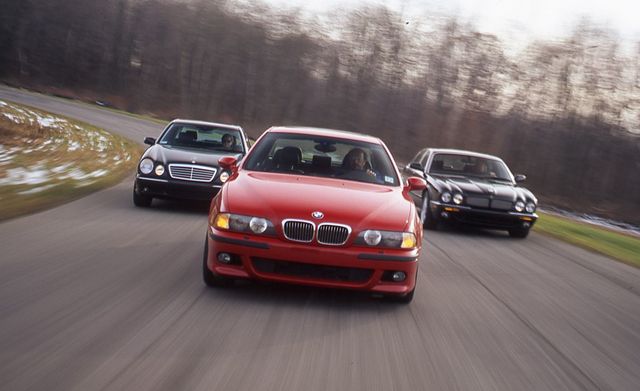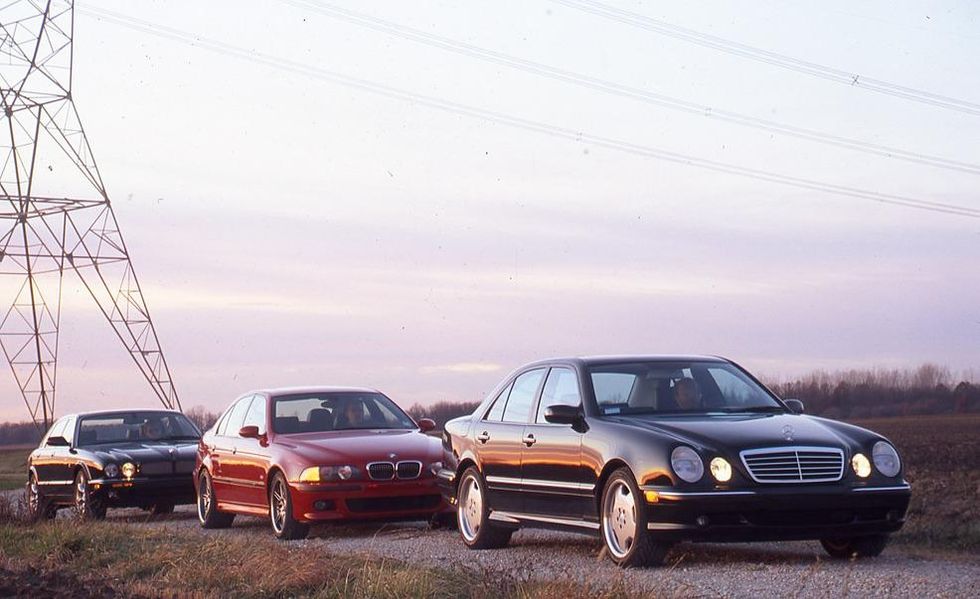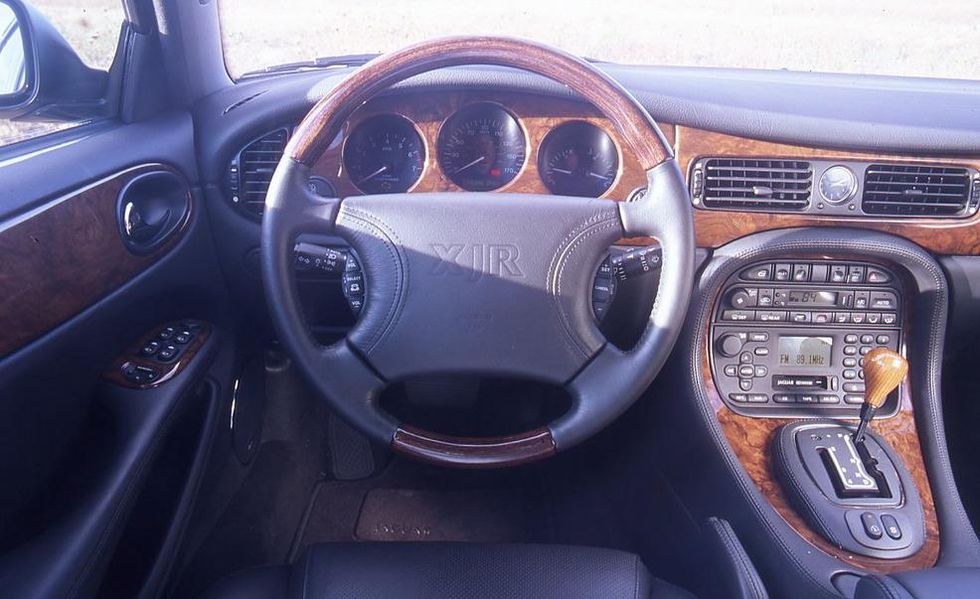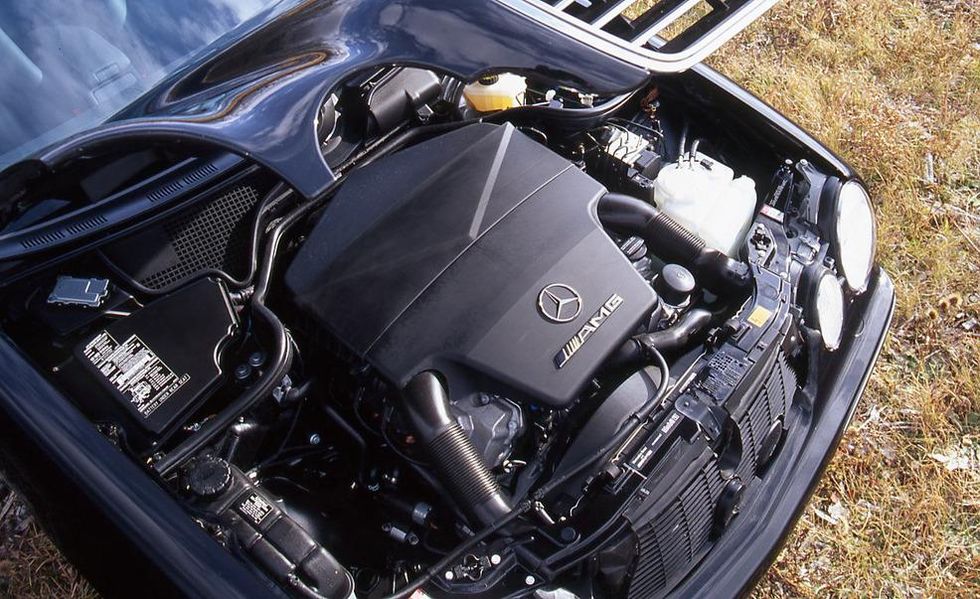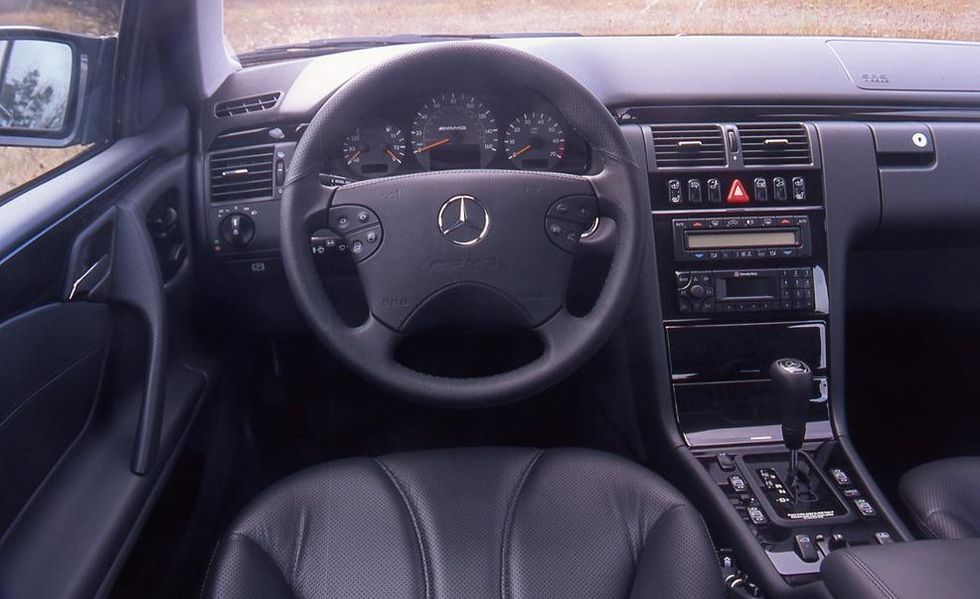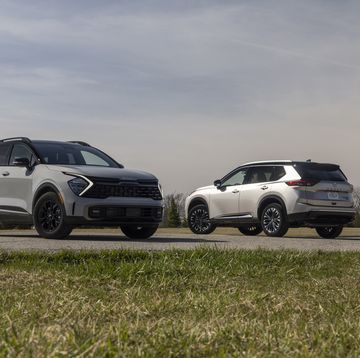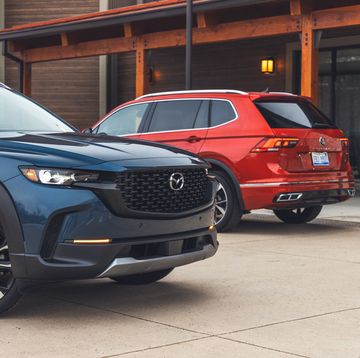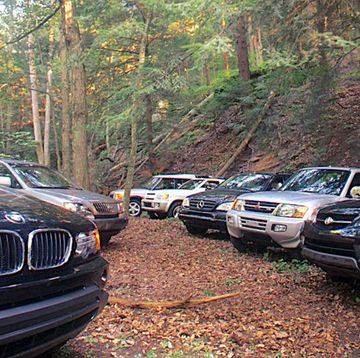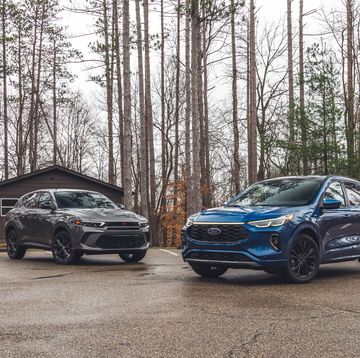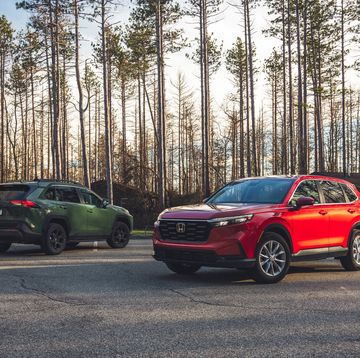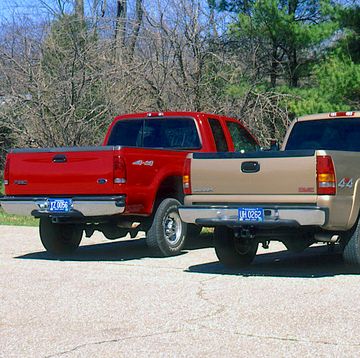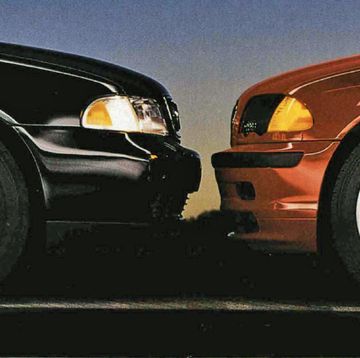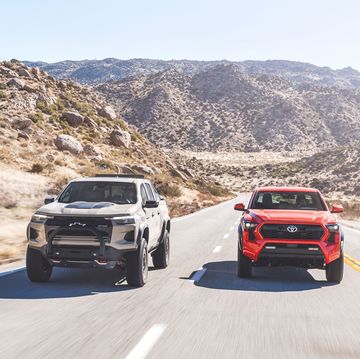From the March 2000 issue of Car and Driver.
On the day it went public, your dot.com company's stock was wildly oversubscribed. Despite a complete inability to return profits, its stock is rising on a trajectory steeper than the space shuttle's. Time to stock your adult toy chest before the investors wise up.
You picked up a pricey two-seater after that glorious public offering, but it's not exactly suited to ferrying you and your colleagues to your daily business meetings. Your swollen stock provides the freedom to buy anything on the market, but showing up every day in a Bentley or a Roller gives the wrong impression in the superficially egalitarian circles of the casually dressed West Coast high-tech executive set. Besides, when you're not rearranging electrons to energize Web traffic, you love driving, and you want a sedan that's as exciting and involving as the low-slung sportster with which it will be sharing garage space.
Among the hundreds of models offered by the world's automakers are three that fit these requirements perfectly. They are all powered by gutsy V-8 engines and are fitted with high-performance suspensions, beefy brakes, and sticky steamroller-like tires. And none of them will raise any eyebrows among the unwashed, because they're all variations on models driven by legions of dentists and tax accountants.
The newest of this robust trio is the BMW M5. It's the third 5-series to be enhanced by the ministrations of the company's motorsports department and the first M5 not powered by a descendant of the 24-valve, twin-cam six introduced in the legendary BMW M1 supercar some 20 years ago.
The engine in this new M5, called the S62, is derived from BMW's 4.4-liter corporate V-8, with several important changes. An increased bore and stroke enlarges its displacement from 4398 to 4941cc. A new induction system with dual air cleaners and airflow meters and eight individual throttles feeds the larger engine's appetite for air. BMW's double VANOS system, which can independently vary the timing of the intake and exhaust camshafts over a range of 60 degrees, makes the most of this deep-breathing induction system. An 11.0:1 compression ratio (up from 10.0:1) extracts maximum energy from the trapped charge, while a low-restriction exhaust system with two catalysts and four thick tailpipes reduces the power lost to back pressure. The result is a mighty 400 horsepower at 6600 rpm and 369 pound-feet of torque at 3800 rpm.
Then there's the Jaguar XJR, introduced for 1998. It too is powered by a V-8, but one that uses forced induction to achieve elevated power. By fitting an Eaton-built roots-type blower that pumps 11.6 psi of boost into the 4.0-liter, four-cam, 32-valve corporate V-8, Jaguar engineers have raised the engine's power from 290 to 370 horsepower and boosted its torque from 290 to 387 pound-feet. And the peak torque is developed at 3600 rpm, 650 revs lower than in the naturally aspirated engine.
The third Stormer is the Mercedes-Benz E55 AMG. It simply follows the old hot rodder's adage, "There is no substitute for cubic inches." AMG took the Mercedes 5.0-liter V-8, complete with its single overhead camshaft and three valves and two spark plugs per cylinder, and stroked it to displace 5439cc. To feed its bigger cylinders, the AMG engine gets hotter camshafts, a redesigned two-stage intake manifold with larger-diameter runners, and a new, dual-intake air cleaner and matching exhaust system. The result is 349 horses at 5500 rpm. This is the lowest power of this trio, but the AMG V-8 's 391 pound-feet of torque is the highest in the group, and at 3000 rpm, this massive twist comes in earlier than in either of the other cars.
Both the E55 and the XJR route their power through the identical five-speed, electronically controlled automatic gearbox built by Mercedes to handle its 6.0-liter V-12. The transmission programming is different in each application. Jaguar uses its unique but aging J-gate shifter, while Mercedes employs its new "Touch Shift" gate to facilitate manual gearchanges. In contrast, the M5 comes only with a six speed manual transmission, adapted from the 540i sedan.
Otherwise, the cars are very closely matched. They all benefit from beefed-up variations of the sophisticated four-wheel independent suspensions of their host platforms, proctored by electronic stability control systems. They are all shod with grippy 18-inch tires—245/40 front and 275/35 rear Michelin Pilot Sports on the M5 and E55, and 255/40 Pirelli P Zeros on the XJR.
Although the Jaguar, at 197.8 inches long, is about 10 inches longer than its rivals, it isn't roomier, making this dimensional variation functionally irrelevant. All three cars are also lavishly equipped with the most sybaritic conveniences, ranging from a power sunshade in the backlight of the Mercedes to the standard navigation system in the M5 to the umbrella that comes with every XJR. All three cars are even priced on top of one another, with their 70-or-so-grand base prices varying by no more than $3072.
In short, this is a perfectly matched trio of four-door bullets. So well matched that we were forced to spend three glorious days wringing them out over the undulating roads of central Ohio, as well as at that scene of so many Car and Driver near-victories, Nelson Ledges Road Course near Warren.
In the end, we found distinct differences among these three magnificent machines. After most comparison tests, we simply turn our backs to the cars and go on our way. At this one, the keys to these machines had to be pried from our desperately clutching fingers. Among cars that can provide practical transportation on a daily basis, these three are the most satisfying in the world.
Third Place: Jaguar XJR
From its fluted hood that echoes its headlamp contours to its crosshatch wire grille and its low and sleek profile, the Jaguar XJR is the looker of the lot. The visual delight continues inside, where sumptuous, fragrant Connolly leather is found alongside more square inches of polished wood trim than either Teutonic competitor offers.
Yet despite its traditionally elegant styling and the age of its platform, which debuted in 1986 as the XJ40, this XJR picks them up and puts them down with youthful muscle. It scooted from a standstill to 60 mph in 5.3 seconds and covered the quarter-mile in 13.9 seconds at 103 mph. Furthermore, it stopped from 70 mph in a short 168 feet and displayed 0.85 g of stick on our skidpad. In other words, this car is a 4015-pound rocket.
Thanks to the immediate response of the supercharged engine, thrust is available instantly and effortlessly at any speed, and there's a bonus. "Love the whine made by the supercharger," wrote one editor. "It sounds like power!" Only at a solidly triple-digit pace, where the XJ's bluff aerodynamic envelope fights a losing battle with the atmosphere, does the XJR suffer any straight-line disadvantage with the other cars.
However, we all perceived a certain baroque feel to the XJ's cockpit. The seat seems a bit high relative to the controls and roof. The mass of switches and buttons grouped in the center console is amorphous and difficult to distinguish. And the XJ's rear seat, whether occupied by two or three passengers, offers markedly less comfort and room than the two other cars'.
None of this will bother the driver after a few miles of acclimatization to the left seat ergonomics. The steering is precise, responsive, and communicative. The suspension works beautifully up to a very brisk pace. Even the ride is remarkably absorbent, given the 40-series, 18-inch Pirelli near-racing tires.
But when you start pushing this R model as fast as it will go, the car loses some of its aplomb. Suddenly, the fluid compliance of the suspension is insufficient to prevent the body from pitching, rolling, and generally moving around more than we'd like. Although the XJR never comes close to stabbing its driver in the back, driving smoothly becomes imperative when you're trying to make this car hustle.
It's also imperative to switch off the traction control because the system's frequent and lengthy interruptions preclude any chance of mimicking Jackie Stewart's fluid style. The anachronistic old J-gate shifter works reasonably well to select the gears manually under these circumstances, but we would prefer a more modern, less attention-intensive manumatic approach.
Although it seems churlish to bring it up, we would also like a slightly heavier load of luxury and convenience features in the Jag. Its competitors provide more seat adjustments, head airbags, a rear center headrest, headlight washers, and several other minor features that the XJR lacks, although it is admittedly the least dear chariot of the bunch.
Altogether, its slight packaging deficiencies and its unhappiness with truly breakneck speeds offset the Jaguar's inarguable visual appeal. As one editor put it, "It seems remarkable to me that a car with this power and capability could finish third in a field of three."
2000 Jaguar XJR
370-hp supercharged V-8, 5-sp automatic, 4015 lb
Base/as-tested price: $70,802/$70,802
C/D TEST RESULTS
60 mph: 5.3 sec
1/4 mile: 13.9 sec @ 103 mph
Top speed: 154 mph
Braking, 70–0 mph: 168 ft
Roadholding, 300-ft-dia skidpad: 0.85 g
C/D observed fuel economy: 14 mpg
Second Place: Mercedes-Benz E55 AMG
Although this particular Mercedes E55 AMG was a bit off the pace compared with one we tested a year ago, it was hardly a slug. A tick behind the XJR to 60 mph, it completed the short sprint in 5.5 seconds and then went on to equal the Jag's 13.9-second quarter-mile run. From there, the E55 easily pulled away from the XJR, thanks to its outstanding 0.29 drag coefficient.
The E55 weighs about 200 pounds less than the two others, and it has the biggest engine with the strongest low-end torque and a most responsive five-speed automatic transmission. Add that up, and the result is a car that needs only a twitch of the driver's right foot to produce some instant squirt. Unfortunately, the Touch Shift mechanism was out of adjustment on this example. When you slapped the stick for a downshift, it would bounce back to the other side and perform an upshift to negate your desire. And in the manual mode, the programming of the Touch Shift also fails to hold gears as single-mindedly as does DaimlerChrysler's AutoStick. Perhaps some interdivisional technology transfer would be in order here.
This was one of several small glitches to which we all had to adapt when first slipping behind the E55's wheel. The steering initially seemed overly sensitive on-center. The brake pedal demands a substantial amount of pressure and travel before it begins to slow the car. And a car with such a responsive powertrain could stand to have more gradual throttle tip-in.
But after a couple of sessions in the car, these niggles were supplanted by praise for the taut chassis and immense capabilities turned out by AMG. "This thing has the grip of an insurance salesman," an editor wrote. Indeed it does, for the big Michelin tires don't begin to slide until you are cornering at 0.90 g. The sticky rubber also combines with the powerful brakes to halt the car from 70 mph in 161 feet.
This grip, combined with tightly controlled suspension motions and excellent balance, makes for a car that's easy to drive quickly. The E55 shrugs off a throttle lift in an unexpectedly tight corner. It switches directions rapidly in high-speed esses. And you can readily ease on the power to rocket out of even tight corners. As a result, at Nelson Ledges the AMG car lapped 2.6 seconds quicker than the XJR.
Our only real complaint during flat-out running had to do with the Mercedes-Benz stability- and traction-control systems. Even when you turn them off, they won't stay off. If you apply the brakes during a hard corner, the systems assume that you are desperately fighting for control and engage one or more of the brake calipers with a mighty jolt. As a result, the seamless trail-braking that we were all taught at Bob Bondurant's driving school is impossible to execute smoothly.
On public roads, this is not likely to be noticed by most drivers as the stability control doesn't step in at all until you are well and truly pressing hard. At a more relaxed pace, the Benz is an extremely comfortable sedan. We all found great comfort in the highly adjustable seat and driving position. The layout of the controls is excellent. And the E55 is extremely well equipped and finished beautifully with fine materials, although our example was a bit dark inside. "Another Teutonic coal bin," noted an editor.
Perhaps, but it is also the limousine of the group, with the roomiest rear seat and the largest trunk. Were in search for such a luxury performance car constrained by the need to frequently carry adults in the rear and cope with long stretches of bumper-to-bumper traffic, the E55 would be our first choice.
2000 Mercedes-Benz E55 AMG
349-hp V-8, 5-sp automatic, 3765 lb
Base/as-tested price: $73,065/$73,065
C/D TEST RESULTS
60 mph: 5.5 sec
1/4 mile: 13.9 sec @ 103 mph
Top speed: 157 mph
Braking, 70–0 mph: 161 ft
Roadholding, 300-ft-dia skidpad: 0.90 g
C/D observed fuel economy: 16 mpg
First Place: BMW M5
How do you characterize a roomy four-door, leather-lined luxury capsule that can keep up with a C5 Corvette? All the way to 150 mph. With quarter-mile performance of 13.3 seconds at 108 mph, let's just call it the fastest production sedan on the planet.
But the new M5 is more than a tire shredding drag racer (the traction control occasionally cuts in during a hard three-four shift over bumpy pavement—at 110 mph). It stopped from 70 mph in the shortest span (156 feet), it performed emergency-lane-change maneuver successfully at the highest speed (66.2 mph), and it tied for the best cornering grip at 0.90 g. The M5 is simply a remarkably well-rounded performance machine.
The engine makes its presence known the first time you toe into the throttle. Not only is response immediate and strong, but it also takes on an alto scream as the tachometer needle curls past 5000 revs. "Right next to the Ferrari note," said one driver. Yet at a more sedate pace, the engine is almost as silent as it is in any 5-series sedan.
The M5 is remarkably civilized in other ways as well. Despite running on extreme high-performance tires, inflated to 44 psi front and 49 psi rear, the M5 feels absorbent over pockmarked Michigan and Ohio roads. The bumps are heard more than they're felt, and they're only heard because the M5's cabin is otherwise so hushed. Wind noise is low, the engine is muted when you're not pressing it, and on clear pavement, the car drives with an uncanny, otherworldly smoothness.
One of the joys of this car is the six-speed manual gearbox, which we found ourselves shifting for the sheer joy of it. Although based on the optional unit in the 540i, the beefed-up M5 version shifts with less effort but greater precision. We quickly executed perfectly smooth shifts without conscious effort. The gearbox also employs a relatively short ratio in top gear for plenty of acceleration without downshifting, if you're feeling lazy.
Although the M5's steering feels slightly vague at first, we all quickly grew fond of it. This car became the favorite of the three drivers when the going got fast and challenging. The car's immense grip, vice-less handling, and very precise controls assisted the M5 to the quickest lap times on the track, a second and a half swifter than the E55, without breaking a sweat.
Of course, such work requires switching off the DSC, which is BMW-speak for traction-and-stability control. This system engages inordinately early and could use a sport mode, as Ferrari employs, to reduce its sensitivity when desired. The M5's sport button only increases the effort of the power-steering system and quickens the electronic linkage between your right foot and the V-8.
As a people mover, the M5 falls in between the two other speedy sedans with a very comfortable rear seat, although it does not have the leg-crossing space that the Mercedes offers.
Creature comforts are in abundance, from a standard navigation system to auto-leveling Xenon headlights. Interior finish is also outstanding. Its beautifully stitched, soft leather upholstery and a headliner tailored from Alcantara add up to a very rich-feeling, high-end ambiance.
We're not, however, totally sold on the metallic trim that BMW has fitted in place of wood on the dashboard. It has a vaguely plasticky look to it, as does the shift knob that seems like a plastic imitation of titanium. "Metalloid" is the term we quickly applied for it.
That said, our visceral craving for this car is not curtailed even slightly by that nit. For people who love cars, the BMW M5 is quite simply the most desirable sedan in the world at any price. What more can we say?
2000 BMW M5
400-hp V-8, 6-sp manual, 3976 lb
Base/as-tested price: $73,874/$73,874
C/D TEST RESULTS
60 mph: 4.8 sec
1/4 mile: 13.3 sec @ 108 mph
Top speed: 156 mph
Braking, 70–0 mph: 156 ft
Roadholding, 300-ft-dia skidpad: 0.90 g
C/D observed fuel economy: 14 mpg
Csaba Csere joined Car and Driver in 1980 and never really left. After serving as Technical Editor and Director, he was Editor-in-Chief from 1993 until his retirement from active duty in 2008. He continues to dabble in automotive journalism and WRL racing, as well as ministering to his 1965 Jaguar E-type, 2017 Porsche 911, 2009 Mercedes SL550, 2013 Porsche Cayenne S, and four motorcycles—when not skiing or hiking near his home in Colorado.
